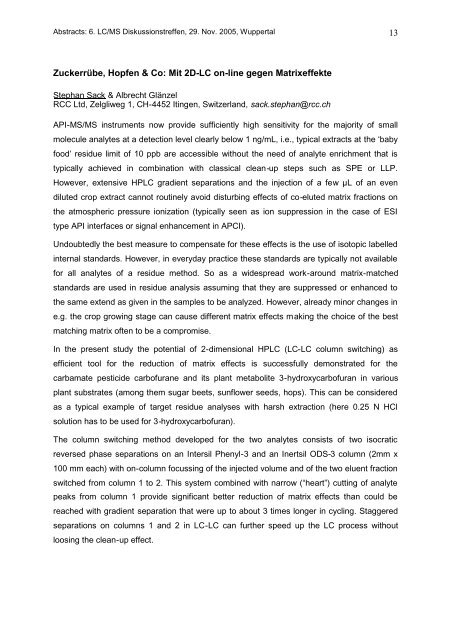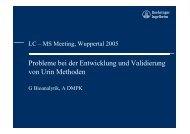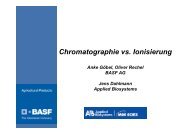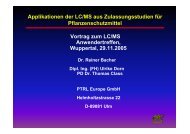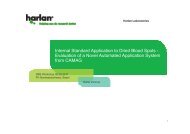6. LC/MS Diskussionstreffen, 29. Nov. 2005, Wuppertal ABSTRACTS
6. LC/MS Diskussionstreffen, 29. Nov. 2005, Wuppertal ABSTRACTS
6. LC/MS Diskussionstreffen, 29. Nov. 2005, Wuppertal ABSTRACTS
Erfolgreiche ePaper selbst erstellen
Machen Sie aus Ihren PDF Publikationen ein blätterbares Flipbook mit unserer einzigartigen Google optimierten e-Paper Software.
Abstracts: <strong>6.</strong> <strong>LC</strong>/<strong>MS</strong> <strong>Diskussionstreffen</strong>, <strong>29.</strong> <strong>Nov</strong>. <strong>2005</strong>, <strong>Wuppertal</strong> 13<br />
Zuckerrübe, Hopfen & Co: Mit 2D-<strong>LC</strong> on-line gegen Matrixeffekte<br />
Stephan Sack & Albrecht Glänzel<br />
RCC Ltd, Zelgliweg 1, CH-4452 Itingen, Switzerland, sack.stephan@rcc.ch<br />
API-<strong>MS</strong>/<strong>MS</strong> instruments now provide sufficiently high sensitivity for the majority of small<br />
molecule analytes at a detection level clearly below 1 ng/mL, i.e., typical extracts at the ‘baby<br />
food’ residue limit of 10 ppb are accessible without the need of analyte enrichment that is<br />
typically achieved in combination with classical clean-up steps such as SPE or LLP.<br />
However, extensive HP<strong>LC</strong> gradient separations and the injection of a few µL of an even<br />
diluted crop extract cannot routinely avoid disturbing effects of co-eluted matrix fractions on<br />
the atmospheric pressure ionization (typically seen as ion suppression in the case of ESI<br />
type API interfaces or signal enhancement in APCI).<br />
Undoubtedly the best measure to compensate for these effects is the use of isotopic labelled<br />
internal standards. However, in everyday practice these standards are typically not available<br />
for all analytes of a residue method. So as a widespread work-around matrix-matched<br />
standards are used in residue analysis assuming that they are suppressed or enhanced to<br />
the same extend as given in the samples to be analyzed. However, already minor changes in<br />
e.g. the crop growing stage can cause different matrix effects making the choice of the best<br />
matching matrix often to be a compromise.<br />
In the present study the potential of 2-dimensional HP<strong>LC</strong> (<strong>LC</strong>-<strong>LC</strong> column switching) as<br />
efficient tool for the reduction of matrix effects is successfully demonstrated for the<br />
carbamate pesticide carbofurane and its plant metabolite 3-hydroxycarbofuran in various<br />
plant substrates (among them sugar beets, sunflower seeds, hops). This can be considered<br />
as a typical example of target residue analyses with harsh extraction (here 0.25 N HCl<br />
solution has to be used for 3-hydroxycarbofuran).<br />
The column switching method developed for the two analytes consists of two isocratic<br />
reversed phase separations on an Intersil Phenyl-3 and an Inertsil ODS-3 column (2mm x<br />
100 mm each) with on-column focussing of the injected volume and of the two eluent fraction<br />
switched from column 1 to 2. This system combined with narrow (“heart”) cutting of analyte<br />
peaks from column 1 provide significant better reduction of matrix effects than could be<br />
reached with gradient separation that were up to about 3 times longer in cycling. Staggered<br />
separations on columns 1 and 2 in <strong>LC</strong>-<strong>LC</strong> can further speed up the <strong>LC</strong> process without<br />
loosing the clean-up effect.


